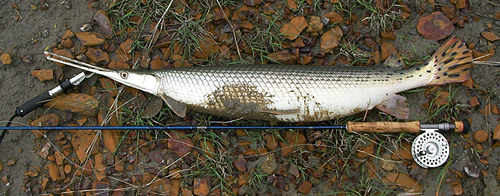
Monday Morning Slidewalk
One more Monday, black with clouds and wet with rain, and all I had to do was go hook up the skiff Sunday evening and pull it out of mothballs – to trigger the torrent today.
I’ve seen wetter springs, but this one? It is somewhat condensed, tightened down to the most critical months of our spring fly fishing here in Texas. Bad timing. We can adapt because that’s what we do, but any worries about an instant boiling in summer heat are washing away as we peal the months off our calendars. We HAVE HAD summers in North Texas that never REALLY got HOT. They are unicorns, but they do exist. Enough of this old folk weather talk! Yes, it is hugely important, and yes, it is starting to be a Statewide problem with salinity levels changing and pushing fish around on the Texas Gulf Coast.
GAR OPS

If you have seen gar in the past, wherever you saw them? You are likely to see them, but that’s the easy part. Getting a gar bite on fly? That’s the hard part. All this fresh water inbound is a solid trigger for gar action, and if YOU want an easy TPWD fly rod record? The TPWD fly rod records for gar are rare, and you could easily be the first to register one on your favorite lake this spring. State TPWD fly rod records are even well within your reach!
There are plenty of gar caught on fly, and we did it on the flats earlier this spring. In that situation, it’s a matter of harassing these flats gar into a bite of a standard carp fly. But for the truly big gar, the air gulpers, we use flies like the rope fly and others that snag teeth and are “hook optional” flies that get snagged in teeth, and are simply a matter of a lightning strike; get the fly in the right place at the right time.
I tie topwater gar flies from Enrico Puglisi fibers that snag and knot when I just look at them sitting in my fly box. That made the fibers a perfect contender for gar flies, but the kicker is I always use hooks and typically deep sproat Gamakatsu B10S Stinger hooks … just in case. The Gamakatsu is a sizable hook that is easy to tie these bulky ugly flies on and the hook is heavy enough gauge to hold your “average” gar. Notice I said “hold,” because (just about) the only way a hook penetrates on a gar is with an in-the-mouth take, equivalent to two lightning strikes in the same spot. It happens, but very rarely.
Tie your gar flies with some bulk, and a lot of shimmy. White is your generally preferred color. Action attracts these gar, and having the ability to give the gar fly action is pretty important. NOW, how much action is part of the art of catching gar on a fly. Gar can also be attracted to dead carrion floating down the river, or washed into the lake. Dead stuff? It doesn’t move much anymore. Your fly fishing power of observation comes in here. What are the gar you see doing? Most of the massive gar I have seen are simply gulping air and circling the cove, but they do congregate and they do eat. Overall, I would say that the gar I have encountered were hard to figure out …
And they’re even more difficult to identify! Gar come in so many varieties, and are here in Texas in so many varieties, it really is pretty incredible. Spotted, long nose, short nose, and alligator gar are abundant in North Texas lakes and river systems. Of course the alligator gar has achieved the most wanted list because of its menace and massive size. Add to that a huge amount of TV exposure, and you actually have a “market” for guiding for giant alligator gar.
By now I’ve caught every variety of Texas gar, and they are actually a fantastic fighting fish. But that catch typically comes at the exhausting end of long, persistent and difficult attempts to actually catch the fish! A gar can wear you out before you even catch the fish – it’s that challenging, for me at least.

You must be logged in to post a comment.